
Neurobiochemistry I: Posterior Pituitary / Hypothalamus
Hypothalamus:
Acts as a link between the CNS and the endocrine system via the pituitary.
Located just above the brain stem it is the size of a cherry.
Produces hypothalmic-releasing hormones that can either activate or inhibit the pituitary.
Posterior Pituitary:
"Master Gland" located at the base of the brain is approximately the size of a pea.
Regulates and controls all other endocrine galnds.
Secretes many hormones including vasopressin and oxytocin.
Vasopressin: because of its ability to increase blood pressure is now called....
Antidiuretic Hormone (ADH): its MOST important physiologic action, promote reabsorption of water from the renal tubules
Oxytocin: stimulates uterine smooth muscle contraction and promotes milk ejection from the mammary gland
Structures of ADH and Oxytocin:

Note: each contains a 1-6 disulfide bridge and a C-terminal Gly amide; they are highly homologous (differing only at positions 3 and 8)
Both hormones are produced in the hypothalamus and transported to nerve endings in the pituitary, where upon appropriate stimulation, the hormones are released into circulation.
Each is transported through axons in noncovalent association with specific carrier proteins called neurophysin I and II respectively.
Neurophysins I and II are synthesized along with oxytocin and ADH/vasopressin
Preprovasopressin and Preprooxytocin:
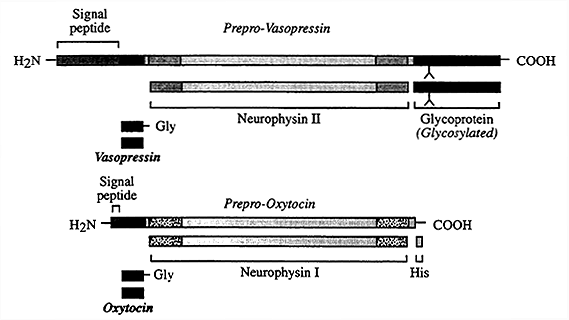
Secretion:
Stimulus-Secretion of Vasopressin Release From Pituitary
Osmotic Pressure: measure of fluid perfusing through membranes
ACh: Acetylcholine, a neurotransmitter
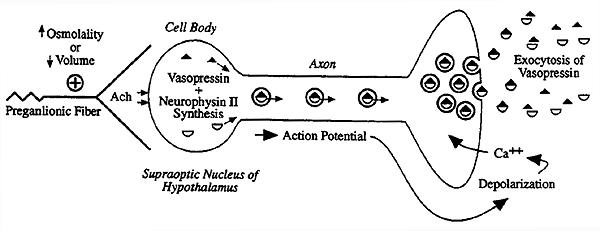
If osmolality increases, vasopressin is secreted to cause H2O retention ("hold-in" H2O in blood) at the kidney, lowering osmolality to normal.
If volume (blood pressure) drops, vasopressin is secreted to act on water reabsorption in the renal tubule cells.
Mechanism of Action in the Kidney Distal Tubule Cell:
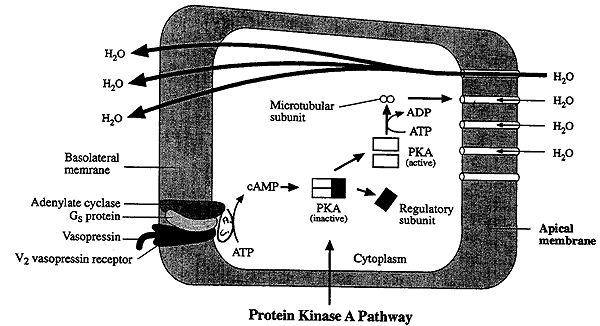
Gs Protein review:

Clinical Correlate:
Diabetes insipidus (distinguish from mellitus...)
Symptoms: excessive thirst and excessive urination
Clinical findings: Urine Glucose test- Negative and Serum Vasopressin Levels- Low
Molecular Cloning: has revealed a preprovassopressin gene mutation ---> lack of Vasopressin
Patients can lose up to 20 L of H2O per day.....
Oxytocin: receptors are induced by estrogen, similar mechanism of action to that of ADH, except oxytocin acts on a Gp receptor producing IP3 and DAG.
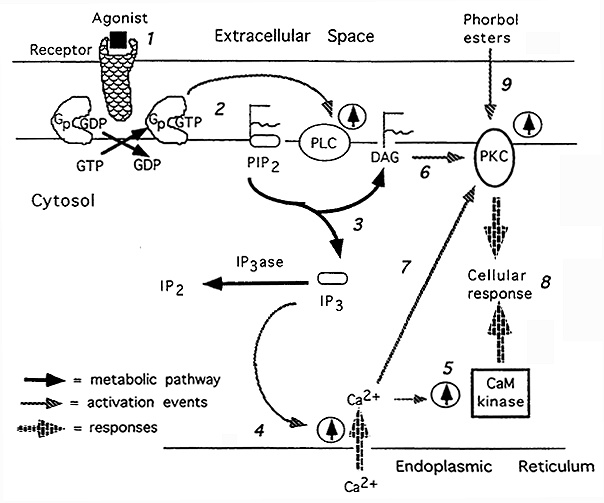
Central Nervous System Activity of Hormones:
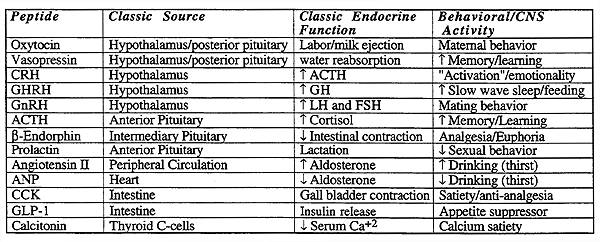
CRH: Corticotropin Releasing Hormone
GHRH: Growth Hormone-Releasing Hormone
GnRH: Gonadotropin Releasing Hormone
ACTH: Adrenocorticotropic Hormone
ANP: Atrial Natriuretic Peptide
CCK: Cholecystokinin
GLP-1: Glucagon Like Peptide-1
LH: Luteinizing Hormone
FSH: Follicle Stimulating Hormone
Each of the hormones listed above probably posses neurons, which act like receptors, releasing them into the brain to orchestrate a behavioral response that is in concert with the particular peripheral physiologic effects of the hormone.
The Hypothalmic Releasing and Inhibiting Peptide Hormones:
The Hypothalamus is a region of the brain, the size of a cherry that controls the sympathetic nervous system.
All of the hypothalmic releasing and inhibiting hormones act on cell surface seven-transmembrane receptors, G-proteins.
Gs, Gi (Effector Protein-Adenylate Cyclase)
Gp (Effector Protein-Phospholipase C)
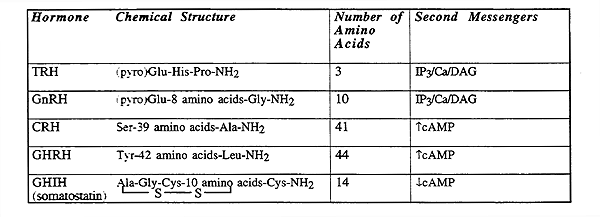
Proposed Model for the Effects of GHRH and Somatostatin on Adenylate Cyclase:
The Gs / Gi story.....

© Dr. Noel Sturm 2015